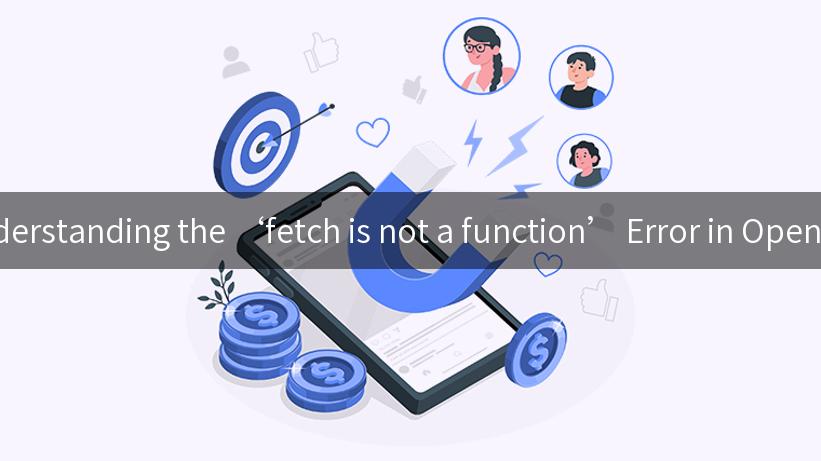
When working with web APIs, developers frequently use JavaScript’s fetch API to make asynchronous requests. However, sometimes you might encounter an error that states 'fetch is not a function'. In this article, we will dissect this error in detail, explore possible causes, and consider solutions, especially in the context of enterprise AI applications, OpenAPI, and Apigee.
What is the fetch API?
Before we dive deeper into troubleshooting the ‘fetch is not a function’ error, let’s briefly cover what the fetch API is. The fetch API is a modern JavaScript method that allows you to send network requests for resources. It returns a promise that resolves to the response of the request. The fetch API is particularly useful for making requests to RESTful services like those defined by OpenAPI specifications.
Basic Example of Fetch
Here is a simple example of how to use the fetch API:
fetch('https://api.example.com/data')
.then(response => response.json())
.then(data => console.log(data))
.catch(error => console.error('Error:', error));
Understanding the 'fetch is not a function' Error
The 'fetch is not a function' error typically occurs in environments where the fetch API is either unavailable or not properly referenced. Common scenarios for this error arise in:
-
Node.js Environment: The fetch API is natively supported in browsers but not in Node.js. If you attempt to use fetch in a Node.js environment without a polyfill, you’ll encounter this error.
-
Incorrect Context: If fetch is being called on an undefined object, or if it’s overwritten in your script, it will lead to this error.
-
Outdated JavaScript Environment: Older environments or browsers that do not support the fetch API will also lead to this issue.
Example Scenarios
Let’s examine some examples of when you might encounter this error, particularly in a development environment:
Example 1: Using Fetch in Node.js
In a Node.js application:
fetch('https://api.example.com/data') // This will throw an error
.then(response => response.json())
.then(data => console.log(data));
Solution: Use a package like node-fetch:
npm install node-fetch
And then import it:
const fetch = require('node-fetch');
fetch('https://api.example.com/data')
.then(response => response.json())
.then(data => console.log(data));
Example 2: Overwriting the Fetch Function
If you mistakenly overwrite the fetch function, you would have a similar error:
const fetch = null; // Incorrectly overwrites the fetch function
fetch('https://api.example.com/data') // This will throw an error
.then(response => response.json())
.then(data => console.log(data));
Solution: Ensure you are using the global fetch function without reassigning it.
Fetch in the Context of OpenAPI
OpenAPI specifications allow you to document RESTful APIs, ensuring consistent and predictable behavior across various implementations. When integrating with OpenAPI, invoking endpoints defined in the specification typically uses fetch.
Suppose you are defining an enterprise-level application needing AI services with Apigee (an API management platform). You might run into the 'fetch is not a function' error due to one of the reasons mentioned above. It’s essential to ensure your API gateway, such as Apigee, includes a reliable method to make HTTP requests.
How to Enhance Enterprise Security When Using AI
Integrating AI services into your enterprise applications can offer significant advantages, but it also raises questions pertaining to security. Here are some best practices for secure AI service invocation:
-
API Token Management: Ensure that you are using dynamic and secure tokens for API access. Avoid hardcoding them into your application.
-
Rate Limiting and Throttling: Implement rate limiting on AI service endpoints to prevent abuse and ensure fair usage.
-
Audit Trails: Maintain logs of API requests and responses. This will help diagnose issues and improve accountability.
-
Data Encryption: Use HTTPS for all API communications and encrypt sensitive data in transit.
-
Regular Updates and Patching: Ensure your application and libraries are updated to protect against vulnerabilities.
Invocation Relationship Topology in an Open Platform
Understanding the Invocation Relationship Topology (IRT) is crucial when designing enterprise applications that leverage multiple services, including AI. The IRT defines how different services communicate with each other through APIs.
Here’s an illustrative table to summarize the essential components of IRT in OpenAPI:
| Component |
Description |
| Service A |
The provider of a primary function. |
| Service B |
An auxiliary service that enhances Service A. |
| Service C |
A data store used to persist information. |
| API Gateway |
Handles requests and ensures secure access. |
| Client |
End-user application that consumes the services. |
By maintaining a clear understanding of how these components interact, developers can avoid common pitfalls and enhance the security features of applications utilizing AI services.
APIPark is a high-performance AI gateway that allows you to securely access the most comprehensive LLM APIs globally on the APIPark platform, including OpenAI, Anthropic, Mistral, Llama2, Google Gemini, and more.Try APIPark now! 👇👇👇
Conclusion
The 'fetch is not a function' error can be frustrating, especially in contexts where APIs are critical to business operations. By understanding possible scenarios leading to this error, developers can troubleshoot effectively. Furthermore, implementing secure practices is vital when leveraging AI in enterprise applications. Utilizing platforms like Apigee alongside proper API management strategies will enhance service reliability, stability, and security.
In sum, always check your environment compatibility with the fetch API, ensure your application is built with security best practices, and maintain a clear architecture for interactions in your API ecosystem. This holistic approach will not only solve existing issues but also safeguard your applications against future challenges.